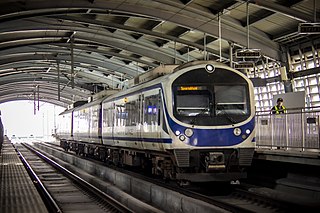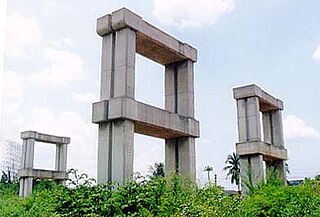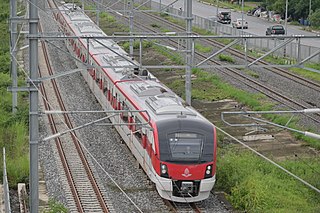
The Metropolitan Rapid Transit or MRT is a mass rapid transit system serving the Bangkok Metropolitan Region in Thailand. The MRT system comprises two fully operational rapid transit lines and two fully operational monorail lines, with another rapid transit line (Orange) under construction. The MRT Blue Line, officially the Chaloem Ratchamongkhon Line, between Hua Lamphong and Bang Sue was the first to open in July 2004 as Bangkok's second metro system. The MRT Blue line is officially known in Thai as rotfaifa mahanakhon (รถไฟฟ้ามหานคร) or "metropolitan electric train", but it is more commonly called rotfai taidin (รถไฟใต้ดิน), literally, "underground train" as it was distinguished from the BTS Skytrain by being completely underground when its first section between Hua Lamphong to Bang Sue opened.

The State Railway of Thailand (SRT) is the state-owned rail operator under the jurisdiction of the Ministry of Transport in Thailand.

Bangkok railway station is a railway station in Pathum Wan, the former central passenger terminal in Bangkok and the former railway hub of Thailand. It is in the center of the city in the Pathum Wan district, and is operated by the State Railway of Thailand (SRT). Long distance trains moved to the new central station at Krung Thep Aphiwat Central Terminal in 2023.

The Airport Rail Link (ARL) is an express and commuter rail line in Bangkok, Thailand. The line provides an airport rail link from Suvarnabhumi Airport to Phaya Thai station in central Bangkok. Most of the line is on a viaduct over the main eastern railway. It is owned by State Railway of Thailand (SRT) and, since 2021, operated by Asia Era One Company Limited. The 28.6-kilometer (17.8 mi)-long Airport Rail Link opened for service on 23 August 2010.

Rail transport plays a crucial role in connecting various regions of Thailand, transporting both goods and passengers through a range of transportation options that include inter-city and commuter rail, mass rapid transit, monorails, and airport rail links. The State Railway of Thailand (SRT) operates a network of intercity railways spanning 4,845.1 kilometers, covering 47 provinces across the country. SRT is committed to developing railway lands through its subsidiary, SRT Asset (SRTA), which focuses on transit-oriented development (TOD) initiatives. The Krung Thep Aphiwat Central Terminal in Bangkok serves as the primary transportation hub for rail transport in Thailand, connecting various types of rail transportation throughout the country. It covers an area of 274,192 square meters, making it the largest railway station in Southeast Asia, and is situated in a new central business district (CBD) that is currently being developed.

The Bangkok Elevated Road and Train System, commonly known as the Hopewell Project after main contractor Hopewell Holdings, was a failed project to build an elevated highway and rail line from central Bangkok to Don Mueang International Airport.

The SRT Dark Red Line, is part of the SRT Red Line suburban railway system to serve the greater Bangkok Metropolitan Region running for 26 km (16 mi) between Krung Thep Aphiwat and Rangsit.

The SRT Light Red Line, or Nakhon Withi Line is a 15 km (9.3 mi) between Krung Thep Aphiwat Central Terminal and Taling Chan and is part of the SRT Red Lines suburban railway system serving the greater Bangkok Metropolitan Region.

The Mass Rapid Transit Master Plan in Bangkok Metropolitan Region, or M-Map, is the latest version in a series of Thai government plans for the development of an urban rail transit network serving the Greater Bangkok area. It was drafted under the care of the Office of Transport and Traffic Policy and Planning (OTP) of the Ministry of Transport.

Rangsit is a city and neighbourhood in Pathum Thani Province, Thailand. Rangsit is a metropolitan city that supports the expansion of Bangkok in the north. Rangsit has become a departure point for travel to provinces in north, northeast, and eastern Thailand.

Eastern Line is a railway line in Thailand, built and owned by State Railway of Thailand (SRT), located in Bangkok, Chachoengsao Province, Nakhon Nayok Province, Saraburi Province, Prachinburi Province, Sa Kaeo Province, Chonburi Province, and Rayong Province. It is the most important freight transport line in Thailand because there are many freight trains on the line. It was opened on 24 January 1907.

Lopburi Line is a railway line of Greater Bangkok Commuter rail, operated by State Railway of Thailand (SRT). The line is all double track. There are seven commuter train services on the line. Main destinations such as Rangsit, Ayutthaya, and Lopburi.

Kaeng Khoi Line is a railway line of Greater Bangkok Commuter rail, operated by State Railway of Thailand (SRT). The line is all double track. There are three commuter train services on the line. Main destinations such as Rangsit, Ayutthaya, Saraburi, and Kaeng Khoi.

Pak Tho station is a railway station located in Pak Tho Subdistrict, Pak Tho District, Ratchaburi. It is a class 2 railway station located 118.628 km (73.7 mi) from Thon Buri railway station.

Krung Thep Aphiwat Central Terminal, also known by its former name Bang Sue Grand Station, is the central passenger terminal in Bangkok and the current railway hub of Thailand. It replaced the existing Hua Lamphong railway station as the city's central railway station, with long-distance rail services operating from here from 19 January 2023. The station was opened on 2 August 2021 as part of the operation of the SRT Red Lines, and from May 2021 to September 2022 served as a COVID-19 vaccination center. It is linked to the Bang Sue MRT station via an underground walkway.

Don Mueang station is a railway station in Bangkok. It is located opposite Don Mueang International Airport. It currently serves the SRT Dark Red Line and long-distance intercity trains on the Northern and Northeastern Line of the State Railway of Thailand. There is a pedestrian bridge directly linking the new station to the airport.

The Gold Line is an automated people mover line, part of Bangkok's rapid transit system. The line is 1.8 km (1.1 mi) long, consisting of 3 stations, and was opened by Thai Prime Minister Prayut Chan-o-cha on 16 December 2020. It primarily serves as a feeder line between the BTS Silom line and Iconsiam shopping center. The line will be extended 1 km (0.62 mi) along Somdet Chao Phraya road to connect with the future MRT Purple Line southern extension. When completed, it will connect Krung Thon Buri BTS station with Prajadhipok Road in Thon Buri District for a total distance of 2.68 km (1.67 mi).
Lak Hok is a tambon (sub-district) in Mueang Pathum Thani district, Pathum Thani province, Greater Bangkok.

Lak Hok Station is a railway station in Mueang Pathum Thani District, Pathum Thani Province. It serves the SRT Dark Red Line.






















